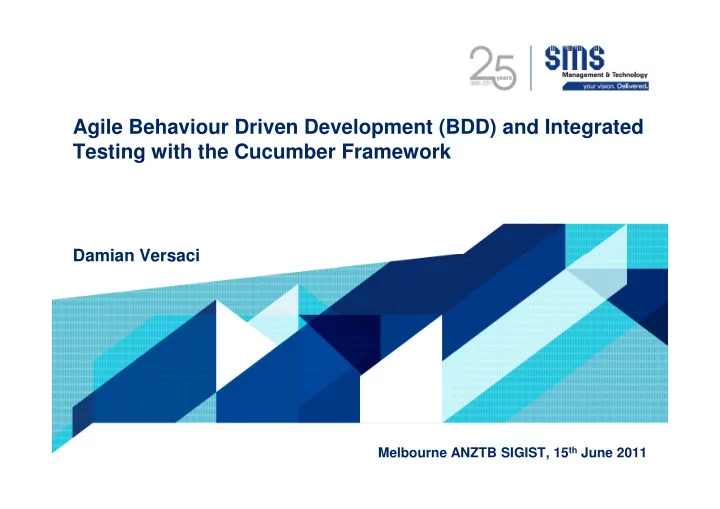

Agile Behaviour Driven Development (BDD) and Integrated Testing with the Cucumber Framework Damian Versaci Damian Versaci Melbourne ANZTB SIGIST, 15 th June 2011
Contents • The Importance of Requirements • Behaviour Driven Development (BDD) Explained • BDD Frameworks (Cucumber, JBehave etc) • Structure of a Feature File (User Story) & Workflow • Benefits • Potential Pitfalls • Potential Pitfalls ��������������������������������������������������������������� �
The Importance of Requirements • NIST estimate 70% of defects are introduced in the requirements phase 1 • Earlier Detected Defects, Cheaper to Correct but prevention even better • Defining & Managing Requirements is generally a difficult exercise – Requirements Elicitation, Elaboration, Validation & Acceptance – Requirements Traceability (Code & Tests) & Change ��������������!!!�"���#��������������#�����������������������"�������� 1 National Institute of Standards & Technology ( $�%&'��((��)&��*��"�����((��(++
Behaviour Driven Development (BDD) Explained – Encourages Collaboration between Business Analysts, QA Engineers, Developers & Business Owners / Stakeholders – Driven by Business Value – Extends Test Driven Development (TDD) by utilizing natural language that non-technical stakeholders can understand – BDD Frameworks such as Cucumber or JBehave are an Enabler, acting a “bridge” between Business & Technical Language – User Stories & Acceptance Criteria Defined in Feature Files with Business Language – Developers Implement Acceptance Criteria �
BDD Frameworks (Cucumber, JBehave etc) – Cucumber is designed for scenario implementation in Ruby, but supports other implementations – JBehave is designed for scenario implementation in Java – Highly Flexible, with ability to integrate with any tool supported by underlying implementation, e.g. - Web Automation (Selenium / Waitr / Capybara) - Various Languages (Java, .NET etc) with Cuke4Duke etc - Build Systems – Ant, Rake, Hudson etc - Various other Tools & Scripting toolkits �
BDD Frameworks Basic .feature (User Story) Structure: ,��������-&����.�� 2 3��������������,������ /��� -)���. 2 %��4���������������5�������� ��!����-%����/�����.������������� 2 /���������#����4���#������� %�������-0��������1����. 2 0��������1�����*������� %���������&���� 2 3��������������%������� 7���� -8����9�. 2 *����������������%������� /���-:����8����9�. ;��� <����'�-/�����. 2 /���������4������%������� /���-=�����/�����. &��� <������������'�-=������. 2 =�������>9������ /���-:����=�������. =�����������%����������������� 6
Structure of a Feature File & Agile Workflow – Step 1: User Story / Requirement Elicitation & Elaboration with Customer(s) or Business Owner – Feature file output – Step 2: User Story (Feature file) Elaboration & Validation with QA – Step 3: Feature & Feature File Implementation by Developers – Step 4: Testers Test Functionality – Step 5: Acceptance by Business Owner – Step 6: Repeat (In Event of Requirement Changes) �
Structure of a Feature File & Agile Workflow ������������������4��4��#�������8��������������,���������������?�&��;��4%���4��@/���� �
Structure of a Feature File & Agile Workflow Step 1: User Story / Requirement Elicitation & Elaboration with Customer(s) and BA ,�������,����=������ %����������������,����%����������� 7���� ���������9�������������� ;��� ����������������� ������������������ &��� ���������������������������������������� ���������������� ���������������� A�����<B)�����2(+C' A�����<B)�����2(+C' A=!�������<C0/C' %���������1��!�5�����)����� A!�� 7���� ����������������#������������� ,���������������3�����3����,����� ;��� ����������������������������� /��� 0�����3����5��� &��������������������#����������� ��!������������������������������������������ /���������������������������������������������� %���������������������������#��� ������ ���������� D
Structure of a Feature File & Agile Workflow Step 2: Elaboration & Validation with BA & QA Engineer %���������3����/�������>9���� ,�������,����=������ 7���� ������9������������������������������� ;��� ����������������� ������������������ &��� ����������������������������������� /�� ���������������������������������������� E�������E ���������������� ���������������� %����������������,����%����������� E����������������E 7���� ���������9��������������������� ��������� %���������1��!�5�����)����� ;��� ����������������� 7���� ����������������#������������� &��� ���������������������������������������� ;��� �������������������������������� ���������������� ������������� &��������������������#����������� /������������������������������������������� +(
Recommend
More recommend